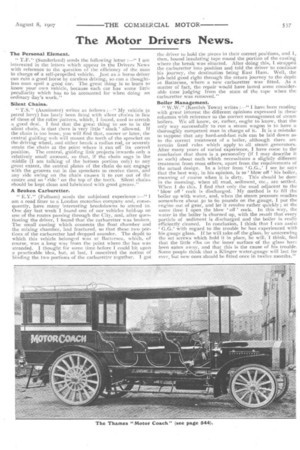The Motor Drivers News.
Page 19

If you've noticed an error in this article please click here to report it so we can fix it.
The Personal Element.
" T.F." (Sunderland) sends the following letter :—" I am interested in the letters which appear in the Drivers News with reference to the question of the efficiency of the man in charge of a self-propelled vehicle. Just as a horse driver can ruin a good horse by careless driving, so can a thoughtless man spoil a goiod car. The great thing is to learn to know your own vehicle, because each car has some little peculiarity which has to be accounted for when doing an ordinary day's work."
Silent Chains.
" T.S.'' (Axminster) writes as follows :—" My vehicle (a petrol lorry) has lately been fitted with silent chains in lieu of those of the roller pattern, which, I found, used to stretch a good deal. I find, that the great thing to see to in the silent chain, is that there is very little ' slack ' allowed. If the chain is too loose, you will find that, sooner or later, the central guidingweb will mount the teeth of the sprocket on the driving wheel, and either break a radius rod, or severely strain the chain at the point where it ran off its correct position. The central, guiding link projects inwards only a relatively small amount, so that, if the chain sags in the middle (I am talking of the bottom portion only) to any great extent, the central plates of the chain do not engage with the grooves cut in the sprockets to receive them, and any side swing on the chain causes it to run out of the centre and so 'ride ' on the top of the teeth. Silent chains should be kept clean and lubricated with good grease."
A Broken Carburetter.
" E.Y." (Fulham) sends the subjoined experience :—" I am a road fitter to a London motorbus company and, consequently, have many interesting breakdowns to attend to. One day last week I found one of our vehicles held-up on one of the routes passing through the City, and, after questioning the driver, I found that the carburetter was broken. The small casting which connects the float chamber and the mixing chamber, had fractured, so that these two portions of the carburetter had dropped asunder. The depot to which this vehicle belonged was at Battersea, which, of course, was a long way from the point where the bus was stranded. I thought for some time before I could hit upon a practicable idea, hut, at last, I conceived the notion of binding the two portions of the carburetter together. I got
the driver to hold the pieces in their correct positions, and I, then, bound insulating tape round the portion of the casting where the break was situated. After doing this, I strapped the carburetter into position and told the driver to continue his journey, the destination being East Ham. Well, the job held good right through the return journey to the depot at Battersea, where a new carburetter was fitted. As a matter of fact, the repair would have lasted some considerable time judging from the state of the tape when the carburetter was removed."
Boiler Management. " W.W." (Kentish Town) writes :—" I have been reading with great interest the different opinions expressed in these. columns with reference to the correct management of steam boilers. We all know, or, rather, ought to know, that the only way successfully to run a steam wagon is to have a thoroughly competent man in charge of it. It is a mistake to suppose that any hard-and-fast rule can be laid down as to the correct treatment of a boiler, although there are certain fixed rules which apply to all steam generators. After many years of varied experience, I have come to the
conclusion that there is a personality (if I may describe it • as such) about each which necessitates a slightly different treatment from most others, apart from the requirements of the actual design. In a letter from G.G.,' I see he says that the best way, in his opinion, is to blow off ' his boiler, meaning of course when it is dirty. This should be done in the morning, when all mud, sediment, etc., are settled. When I do this, I find that only the mud adjacent to the
blow off ' cock is discharged. My method is to fill the boiler up with water, and, when the steam pressure readies somewhere about so to 6o pounds on the gauge, I put the engine out of gear, and let it revolve rather quickly ; at the same time I open the blow off ' cock. In this way, the water in the boiler is churned up, with the result that every particle of sediment is discharged and the boiler is really efficiently cleaned. In conclusion, I think that I can assist G.G.' with regard to the trouble he has experienced with his gauge glass. If he will take off the glass, by unscrewinc.2 the set screws which hold it in place, he will, I think, find that the little ribs on the inner surface of the glass have been eaten away, and that this is the cause of his trouble. Some people think that a Klinger water-gauge will last for ever, but new ones should he fitted once in twelve months."




















